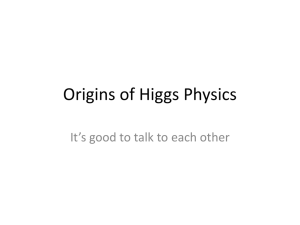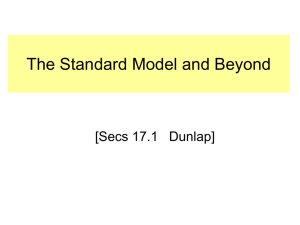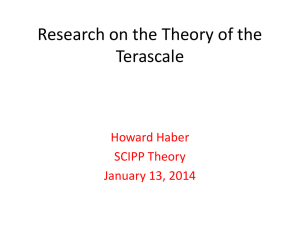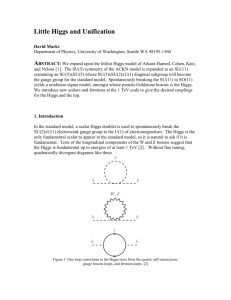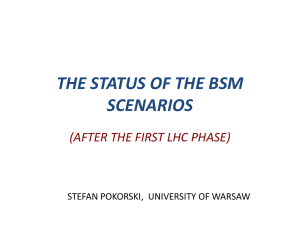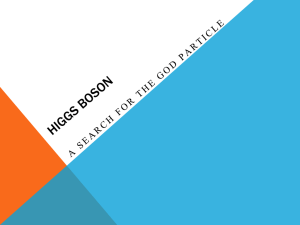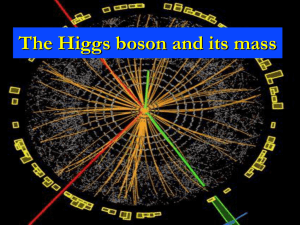PowerPoint ******
advertisement
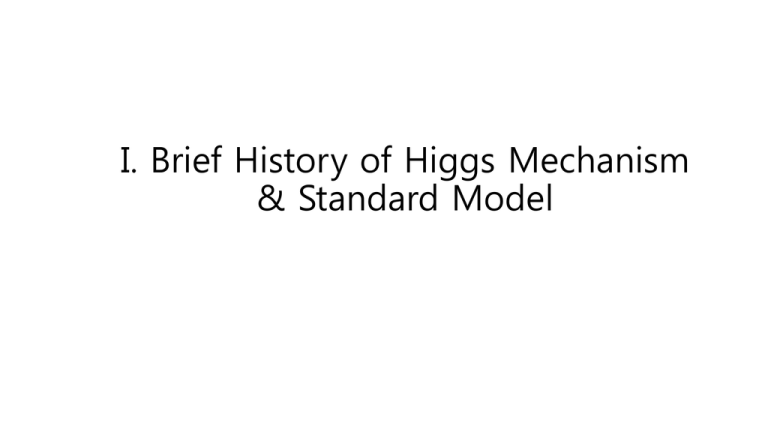
I. Brief History of Higgs Mechanism & Standard Model Implications of Finding a Higgs Boson • It help us to understand the big universal question, what are we made out of ? • It allows us to understand how the particles acquire mass. • We found the missing piece in the standard model. • It helps us to explain how two of the fundamental forces of the universe, the electromagnetic force and the weak force can be unified. • It opens the door ro new calculations that weren’t previously possible, including one that suggests the universe is in for a cataclysm billions of years from now. Implications of Finding a Higgs Boson • It’s a crossroads in science • It allows physicists to try to go where no scientist has gone before • It could lead to unexpected everyday applications • It helps answer basic questions about how the universe evolved • It could change how physics is taught in high school • It’s proof that long, hard work can pay off. Why do we need Higgs boson ? • Quantum electrodynamics works fine without a Higgs boson but the ’weak interactions’ do not. • Fermi developed a theory of weak interaction to describe radioactive decay with a dimensionful coupling GF • Fermi theory is non-renormalizable and thus not fundamental. Why do we need Higgs boson ? • A very important step toward weak interaction was the discovery that the weak four-fermion interactions involved V and A rather than S, T or P. • V–A theory proposed by Marshak & Sudarshan (1957) and by Feynman & Gell-Mann (1958) • This meant that the weak interactions could be seen as due to the exchange of spin-1 W± bosons. This made them seem very similar to electromagnetic interactions mediated by photons. Similarity and Dissimilarity Electromagnetic interaction Weak exchange of spin-1 interaction exchange of spin-1 W± But long range M 0 parity conserving short range M W large parity violating So: Can there be a symmetry relating and W±? Early Unified Models • The first suggestion of a gauge theory of weak interactions mediated by W+ and W– was by Schwinger (1956), who suggested there might be an underlying unified theory, incorporating also the photon. • Glashow (1961) proposed a model with symmetry group SU(2) x U(1) and a fourth gauge boson Z0, showing that the parity problem could be solved• by a mixing between the two neutral gauge bosons. • Salam and Ward (1964), unaware of Glashow’s work, proposed a similar model, also based on SU(2) x U(1) — though neither model used the correct representation of leptons. • But gauge bosons are naturally massless, and in all these models symmetry breaking, giving the W bosons masses, had to be inserted by hand. Electroweak symmetry breaking Sep 2012 8 Massive vector bosons • Gauge theories naturally predicted massless vector bosons. • If masses were added by an explicit symmetry-breaking term, then the vector-meson propagator would not be ig k • It 2 k k g 2 2 m m i But rather k 2 generates a much worse divergence, and the theory is clearly not renormalizable. • So the question started to be asked: could the symmetry breaking that gives rise to vector boson masses be spontaneous symmetry breaking? Broken symmetries • Spontaneous breaking of gauge symmetry, giving mass to the plasmon, was known in superconductivity. • Nambu (1960) suggested a similar mechanism could give masses to elementary particles. • Nambu and Jona-Lasinio (1961) proposed a specific model L int g [( ) ( 5 ) ] 2 — phase symmetry — chiral symmetry i is exact e e 5 0 2 is spontaneously broken m 0 Spontaneous Symmetry Breaking • • • Spontaneous breaking of symmetry occurs when the ground state or vacuum state does not share the symmetry of the underlying theory. It is ubiquitous in condensed matter physics Often there is a high-temperature symmetric phase, and a critical temperature below which the symmetry is spontaneously broken — crystallization of a liquid breaks rotational symmetry — so does Curie-point transition in a ferromagnet — gauge symmetry is broken in a superconductor • Could this work in particle physics too? • Particle physics exhibited many approximate symmetries — it was natural to ask whether they could be spontaneously broken Nambu-Goldstone bosons • But there was a big problem in Spontaneous Symmetry Breaking— Goldstone theorem: spontaneous beaking of a continuous symmetry implies the existence of massless spin-0 bosons,none of which had ever been seen. • e.g. Goldstone model L * V — vacuum breaks symmetry: 0 0 — choose 0 and set 1 2 V 1 2 1 2 2 e V 1 2 ( * i 2 ( 1 i 2 ) cubic and quartic terms 2 2 2 So m 1 , m 2 0 (Goldstone boson) 1 2 2 ) 2 Nambu-Goldstone bosons • This was believed inevitable in a relativistic theory (Goldstone, Salam & Weinberg 1962). • Other models with explicit symmetry breaking were clearly divergent, giving infinite results No observed massless scalars continuous symmetry ! no spontaneous breaking of a • How is the Goldstone theorem avoided ? Higgs mechanism • In 1964, Englert & Brout , Higgs , Guralnik, Hagen & TK found that • The argument fails in the case of a gauge theory, e.g. in Coulombgauge QED, commutators do not vanish at spacelike separation. • Higgs model (gauged Goldstone model): L D * D D ieA again set 1 2 L 1 2 1 4 1 4 V F A A ( 1 i 2 ) 1 1 F F F F B A 1 2 1 2 2 1 2 1 e V 2 e B B 2 2 1 2 ( * 1 2 2 ) 2 F B B cubic terms ... Thus the massless gauge and Goldstone bosons have combined to give a massive gauge boson. Electroweak (Standard) Model • The electroweak model of Weinberg and Salam was basically Glashow’s SU(2) x U(1) model together with a doublet of Higgs fields interacting with leptons. — gauge fields: W , Z , 0 — Higgs fields: complex doublet, four real fields — three give masses to W ,Z — leptons form left-handed doublet — and a right-handed singlet 0 , fourth is physical Higgs e ,e L eR SM & WW scattering - Without the higgs, we get M s / mW2 for large s, and unitarity of scattering amplitude is violated! Summary of the Standard Model • Particles and SU(3) × SU(2) × U(1) quantum numbers: • Lagrangian: gauge interactions matter fermions Yukawa interactions Higgs potential 2. Higgs Boson The Higgs boson • But after 1983 it started to assume a key importance as the only missing piece of the standard-model jigsaw. • The standard model worked so well that the boson (or something else doing the same job) more or less had to be present. • Finding the Higgs was one of the main objectives of the LHC. Discovery of the Higgs boson • Two great collaborations, Atlas and CMS have over a 20-year period designed built and operated marvellous detectors. CMS under construction Possible Higgs event • Result: almost certain discovery of the Higgs (of some kind) Did the LHC experiments see the Higgs particle? Two experiments, Atlas and CMS, reported 5𝜎 results. Has the Higgs been Discovered? Interesting hints around Mh = 125 GeV ? CMS sees broad enhancement ATLAS prefers 125 GeV Is it really the Higgs? • The evidence for a particle at around 125 GeV is now very strong, but is it the standard-model Higgs? There is still a lot of work to do in the next few months — we know it is a boson of even spin, but is it definitely 0, not 2? — we know it decays into the expected channels, but are the branching ratios those predicted by the standard model? — there are some hints of possible discrepancies • I think it is almost surely some sort of Higgs, but there are other possibilities beyond the standard-model Higgs Is this the end of particle physics? • Definitely • The No! There are many outstanding questions still to be answered. standard model is wonderfully successful, but it is a mess — it has something like 20 arbitrary parameters whose values we cannot predict, e.g. ratios of particle masses, or why 3 generations — it is not a unified model, being based on the symmetry group SU(3) x SU(2) x U(1), with three independent coupling strengths • There are suggestions that all three interactions become truly unified at an energy scale of about 1015 GeV — one of the reasons for favouring supersymmetry is that this grand unification idea works much better in a supersymmetric extension of the standard model.
